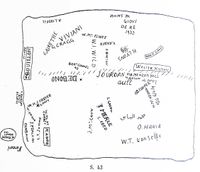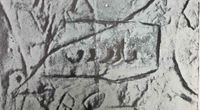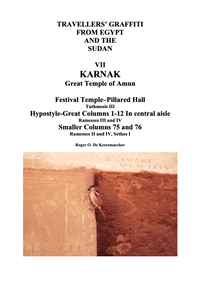INTRODUCTION
19th Century Travellers Graffiti in Egypt - The Underdog
Despite its historical and cultural value, only two major studies about the graffiti left by 19th century travellers who had visited the ancient sites along the Nile have been published....
In the 1940s King Farouk of Egypt ordered with the Egyptian Ministry of State for Antiquities the egyptologist Georges Goyon to document the graffiti of the Great Pyramid of Giza. In 1944 Goyon published his research in Les inscriptions et graffiti des voyageurs sur la Grande Pyramide.
Goyon numbered the stones and documented the graffiti in drawings.
King Farouk's graffito on top of the Great Pyramid, 1935.
In the early 2000s egyptologist Roger O. De Keersmaecker published his research in Travellers' Graffiti from Egypt and Sudan documenting over 1.500 names on ancient palaces, temple sites and tombs along the Nile left by visitors in the 1800s.
In their research both authors included information, if available on the visitor who had left their name as a graffito.
With more historical online sources nowadays available, such as travel diaries and older photographs taken in the mid 1850s, this research project will:
1. Continue and update, eighty years later, the Egyptian Ministry of State for Antiquities' project lead by Goyon and Keersmaecker's documentations, with adding some new found graffiti, as well as adding further quotes, comments and biographical information about 19th century visitors who had left their names along the Nile.
It was Goyon himself wishing his research to be continued and enriched:
"Un jour peut-être quelque érudit puisera dans cet ouvrage de quoi enrichir d'un détail ou d'un fait nouveau un événement historique sur lequel il projettera une lumière plus vive. Ce livre renferme, entre autres, des noms qui pourront présenter un certain intérêt dans l'avenir [...]".
2. What were the views by other 19th century tourists who had noticed the graffiti during visits to the ancient sites? As some travellers later report in diaries, letters and other publications of seeing inscriptions during their travels along the Nile.
3. The new information, along with previous published results, is currently being recorded into tables with further references for research. Lists, some with names and location, will be continuously updated here.
4. Extend this study including further countries, such as Palestine, the Levant, especially the ruins of Baalbek that have not been documented so far, Syria, Jordan, the Arab Peninsula and wherever this research project may take me.
Georges Goyon copying graffiti on the Great Pyramid of Giza.





